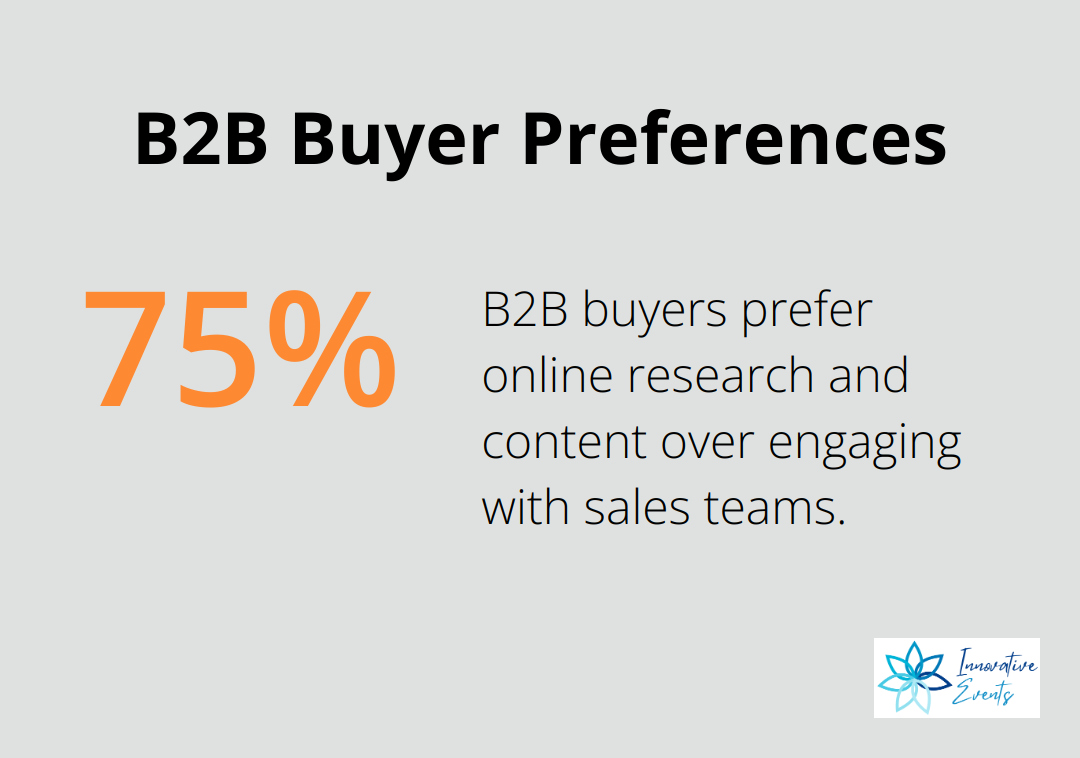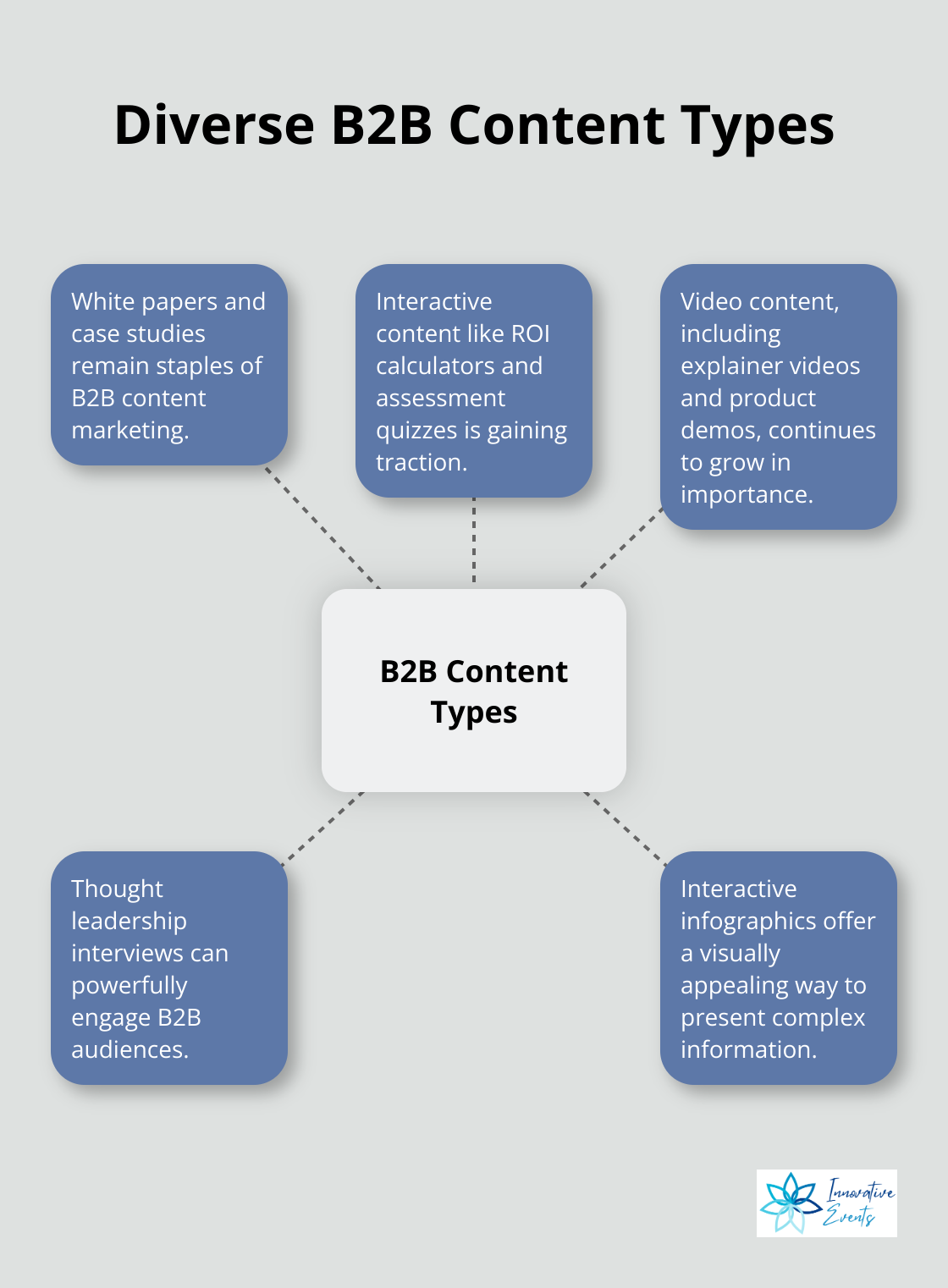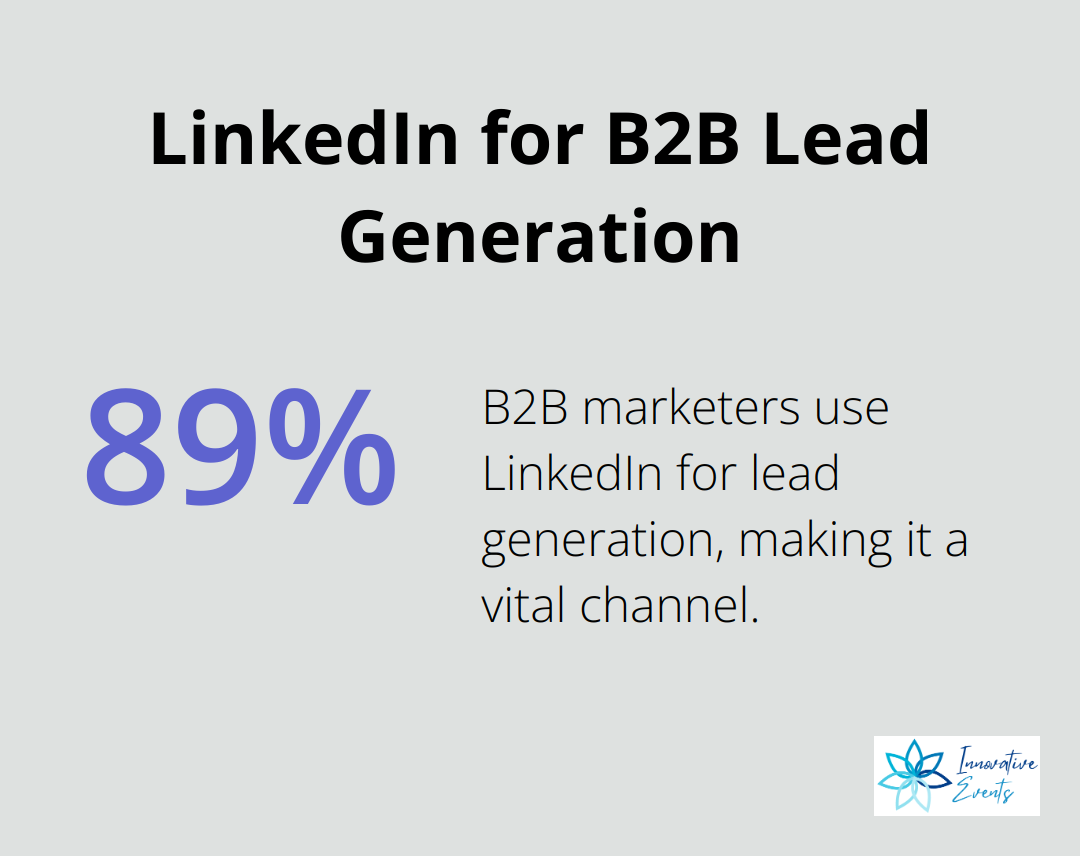B2B content marketing is a powerful tool for driving business growth and establishing industry authority. At Innovative Events, we’ve seen firsthand how effective content strategies can transform B2B relationships and boost revenue.
This blog post will explore the key elements of successful B2B content marketing, from understanding your audience to measuring your results. We’ll share practical tips and insights to help you create content that resonates with your target market and drives real business results.
What is B2B Content Marketing?
Defining B2B Content Marketing
B2B content marketing is a strategic approach that focuses on the creation and distribution of valuable, relevant, and consistent content to attract and retain a clearly defined audience. This method drives profitable customer action and builds long-term relationships with business clients.
The Unique Nature of B2B Content Marketing
B2B content marketing differs significantly from B2C strategies. While B2C often targets quick conversions, B2B content marketing nurtures relationships over time. A study by the Content Marketing Institute reveals that 83% of B2B marketers use content marketing to build credibility and trust with their audience.
One key difference lies in the decision-making process. B2B purchases often involve multiple stakeholders and longer sales cycles. Your content must address the concerns of various decision-makers (from C-suite executives to end-users). This complexity necessitates a more nuanced approach to content creation.
Effective Content Types for B2B Audiences
When you craft B2B content, focus on providing in-depth, educational material that showcases your expertise. Case studies, white papers, and industry reports prove particularly effective. 75% of B2B buyers prefer not to engage with a sales team at all, relying instead on online research and content consumption to guide their decision-making.

Webinars and video content are increasingly popular in the B2B space. These formats allow for more detailed explanations of complex products or services and provide opportunities for direct engagement with potential clients.
Setting Clear Goals for B2B Content Marketing
Setting clear goals is essential for any B2B content marketing strategy. Common objectives include:
- Increasing brand awareness
- Generating high-quality leads
- Establishing thought leadership
- Supporting the sales process
To track these goals, focus on metrics that align with your business objectives. For example, if lead generation is a priority, monitor metrics like conversion rates and the number of Marketing Qualified Leads (MQLs) generated.
The Long-Term Nature of B2B Content Marketing
B2B content marketing is a long-term strategy. While it’s important to track short-term metrics, don’t lose sight of the bigger picture. Building relationships and establishing trust takes time, but the payoff in customer loyalty and sustained business growth is substantial.
As we move forward, let’s explore the specific strategies that make B2B content marketing truly effective. These tactics will help you create content that resonates with your target audience and drives real business results.
How to Create Winning B2B Content Strategies
Know Your Audience Inside and Out
Understanding your target audience forms the foundation of any successful B2B content strategy. Develop detailed buyer personas that go beyond basic demographics. Focus on your customers’ pain points, goals, and decision-making processes.
A Corporate Visions study found that more informed buyers don’t necessarily make better decisions, and growing buying committees can slow down deals. This underscores the importance of tailoring your content to address specific customer needs and challenges throughout the buying process.
To create these detailed personas, combine data from your CRM, conduct customer interviews, and analyze industry trends. Map out the entire customer journey, from initial awareness to post-purchase support. This comprehensive view will help you create content that resonates at every stage of the buying process.
Diversify Your Content Portfolio
White papers and case studies remain staples of B2B content marketing, but it’s essential to diversify your content types to engage different segments of your audience.
Interactive content gains traction in the B2B space. Try incorporating tools like ROI calculators, assessment quizzes, or interactive infographics into your content mix.
Video content continues to grow in importance. Explainer videos, product demos, and thought leadership interviews can powerfully engage B2B audiences.

Master Content Distribution
Creating great content is only half the battle. To maximize its impact, you need a solid distribution strategy. LinkedIn remains a powerhouse for B2B content distribution.
However, don’t limit yourself to a single channel. Explore industry-specific forums, partner with complementary businesses for co-marketing initiatives, and leverage employee advocacy programs to expand your reach.
Email marketing remains a highly effective channel for B2B content distribution. Personalize your email campaigns based on recipient behavior and preferences to improve engagement rates.
Optimize for Search and User Intent
SEO ensures your content reaches your target audience. Focus on long-tail keywords that align with specific buyer intent. Tools like SEMrush or Ahrefs can help you identify high-value keywords in your industry.
But SEO isn’t just about keywords. Google’s algorithms increasingly prioritize content that demonstrates expertise, authoritativeness, and trustworthiness (E-A-T). Showcase your industry knowledge, back up claims with data, and include expert opinions to boost your content’s credibility.
User intent should guide your content creation. Analyze search queries to understand what information your audience seeks at different stages of the buying journey. Then, create content that directly addresses these needs, whether it’s educational blog posts for the awareness stage or detailed product comparisons for the decision stage.
These strategies will help you create a B2B content marketing approach that not only attracts potential clients but also nurtures them through the sales funnel. In the next section, we’ll explore how to measure the success of your B2B content marketing efforts and use data to refine your strategies.
How to Measure B2B Content Marketing Success
Focus on Revenue-Driven Metrics
At Innovative Events, we prioritize metrics that directly tie to revenue growth. Instead of tracking vanity metrics (like page views or social media likes), we concentrate on indicators that demonstrate real business impact.
Key metrics to monitor include:
- Marketing Qualified Leads (MQLs): These leads show a higher likelihood of becoming customers based on their content interactions.
- Conversion Rate from MQL to SQL: This metric reveals how effectively your content nurtures leads through the sales funnel.
Companies with strong sales and marketing alignment achieve a 32% higher revenue growth rate (Forrester Research). This statistic underscores the importance of tracking these revenue-focused metrics.
Track Content Performance Across Channels
Different content pieces will yield varying results across channels. We recommend using tools like Google Analytics to monitor website content performance. Pay attention to:
- Time on page
- Bounce rate
- Pages per session
These metrics provide insights into content engagement levels.
For email marketing, focus on:
- Open rates
- Click-through rates
- Conversion rates
The average return on email marketing is $42 for every $1 spent (a 4,200% ROI).
On platforms like LinkedIn, track:
- Engagement rates
- Shares
- Click-throughs to your website
89% of B2B marketers use LinkedIn for lead generation, making it a vital channel to monitor.

Leverage Advanced Analytics Tools
To gain a comprehensive view of content performance, consider using advanced analytics tools. Platforms such as HubSpot or Marketo offer detailed insights into how content contributes to lead generation and nurturing.
These tools can help attribute revenue to specific content pieces, providing a clear picture of which content types drive the most business value. This information proves invaluable for refining your content strategy and allocating resources effectively.
Use Data to Improve Continuously
The real power of measuring B2B content marketing success lies in using insights to refine and improve your strategy. We suggest reviewing your performance data regularly to identify trends and patterns.
For example:
- If long-form blog posts consistently outperform shorter articles in lead generation, you might invest more resources in creating in-depth content.
- If video content drives higher engagement rates on LinkedIn, you could prioritize video production in your content calendar.
The goal isn’t just to collect data, but to use it to make informed decisions that propel your B2B content marketing strategy forward.
Final Thoughts
B2B content marketing has become an essential tool for driving business growth in today’s competitive landscape. A well-executed content strategy can significantly impact lead generation, brand authority, and revenue. The key to success lies in understanding your audience, creating diverse and valuable content, and using data to refine your approach continuously.
We anticipate several exciting trends in B2B content marketing, including interactive content, sophisticated personalization, and the growing importance of video content. As the digital landscape evolves, businesses must stay agile and adapt their content strategies to new platforms and technologies. This approach will help create meaningful connections with audiences and drive sustainable growth.
At Innovative Events, we understand the power of strategic content in driving business success. Our “9 Summits in 9 Months” initiative showcases how tailored, high-value content can address specific needs and deliver tangible results. You can apply these B2B content marketing principles to your own strategy and create lasting relationships with your audience.

